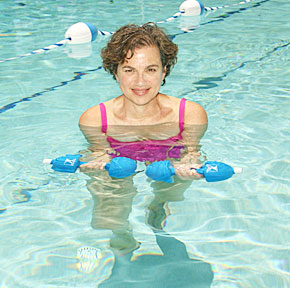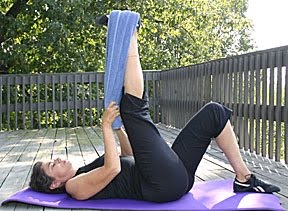 Here’s a question about Arthritis Exercises.
Here’s a question about Arthritis Exercises.
Recently, I got a question from a woman who said, “The arthritis in my hips has progressed to the point where I’m really feeling it after my half hour walks. I want to stay mobile as I age. Are there any Arthritis exercises that will help me do this?”
It so happens, my husband also has osteoarthritis in his hips and I have been helping him with a couple of gentle stretches after his treadmill workouts.
Arthritis Exercises: Land
Here are two exercises that flex and extend the hip as well as stretch the front and back of your thigh muscles.
 1. Lie on your back with one knee bent with your foot firmly on the floor to help support your back. Wrap a towel around the arch of your other foot. Hold the ends and pull back as you extend the leg towards the ceiling flexing your foot. Hold for 10-30 seconds. Feel the stretch in the back of the thigh (hamstring) and in your hip. Repeat on the other leg.
1. Lie on your back with one knee bent with your foot firmly on the floor to help support your back. Wrap a towel around the arch of your other foot. Hold the ends and pull back as you extend the leg towards the ceiling flexing your foot. Hold for 10-30 seconds. Feel the stretch in the back of the thigh (hamstring) and in your hip. Repeat on the other leg.
 2. Lie on your side with both knees bent Take your top hand and grab your top foot at the ankle. Tilt your pelvis forward and pull in your abs as your bring the ankle towards your buttocks. Hold 10-30 seconds. Feel the stretch in the front of your thigh (quadriceps) and in your hip. Turn over and repeat on the other leg.
2. Lie on your side with both knees bent Take your top hand and grab your top foot at the ankle. Tilt your pelvis forward and pull in your abs as your bring the ankle towards your buttocks. Hold 10-30 seconds. Feel the stretch in the front of your thigh (quadriceps) and in your hip. Turn over and repeat on the other leg.
Arthritis Exercises: Aqua
Also, if you have access to a pool, light aquatic aerobics or swimming is great. Your buoyancy in the water will help take the pressure off your joints and allow you to work on increasing your range of motion. The warmer the water the better. If the water seems cold to you, invest in a neoprene shorty weight suit. You can find them in a sporting goods store or dive shop. Here’s is a short aqua video that you can use to get started:
Of course always consult your doctor before beginning any exercise program.
 SPECIAL 25% OFF ALL DVDS, & EQUIPMENT UNTIL AUGUST 31, 2018 Put FABNOW AT CHECKOUT http://www.mirabaiholland.com GET STRONG LIVE LONG
SPECIAL 25% OFF ALL DVDS, & EQUIPMENT UNTIL AUGUST 31, 2018 Put FABNOW AT CHECKOUT http://www.mirabaiholland.com GET STRONG LIVE LONG
Join Certified Exercise Physiologist & Health Coach Mirabai Holland on:











